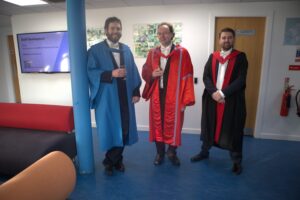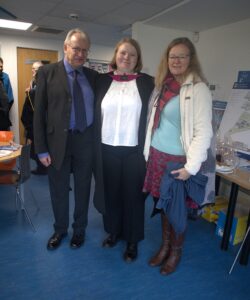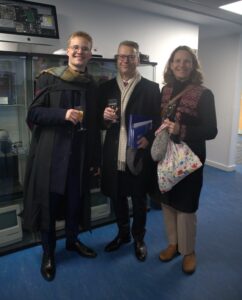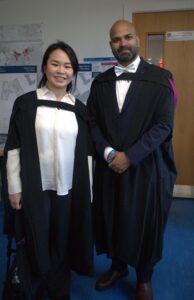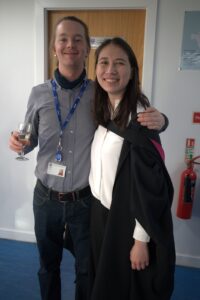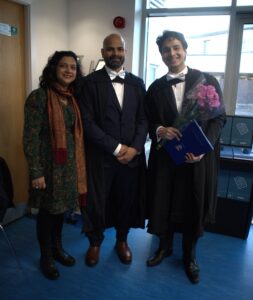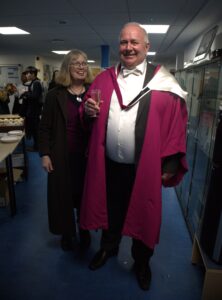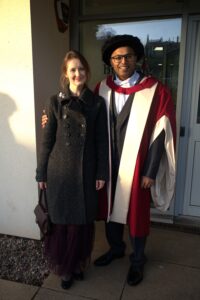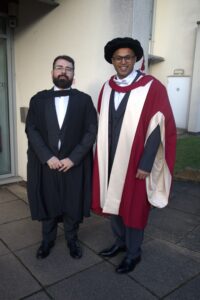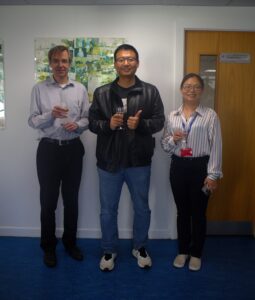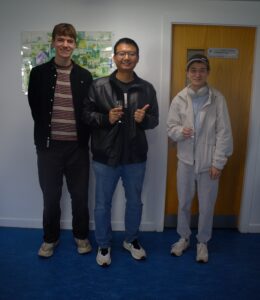Postgraduate
PhD studentships available for 2026 entry
The School of Computer Science at the University of St Andrews is offering a number of PhD scholarships for 3.5 years of study in our doctoral research programme for entry in 2026/7. UK, EU and International students are all eligible for fully-funded scholarships consisting of tuition and a stipend. These awards are part-funded through the University of St Andrews’ ‘handsel’ scheme for tuition waivers.
The School of Computer Science is a centre of excellence for computer science teaching and research, with staff and students from Scotland and all parts of the world. It is a member of the Scottish Informatics and Computer Science Alliance (SICSA).
More details on how to apply can be found on the University Scholarships page. The closing date for equal consideration is 1 Feb 2026.
We strongly advise potential applicants to read our School PGR web pages and to find a supervisor prior to applying. Any questions can be directed to pg-admin-cs@st-andrews.ac.uk.
PGR Seminar: Ben Claydon and Joseph Loughney
You are warmly invited to the next PGR Seminar.
![]() Monday 17/11/2025
Monday 17/11/2025
![]() 14:00-15:00
14:00-15:00
![]() JC 1.33A
JC 1.33A
- Speaker: Ben Claydon
Title: Improvements to Space Partitioning Trees for Similarity Search
Abstract: Searching large, unstructured collections of data for objects deemed of relevance to a user-provided query is an increasingly important task. For example, when a user inputs a query into a search engine, they expect a list of high-quality results to be returned nearly immediately. However, if the search engine had to rank each of the approximately 1 billion websites on the internet in order of relevance to your query, and each of these judgements took 1 microsecond, each web search would take nearly half an hour! To overcome this, data structures are created which enables searching only a small subset of the dataset, where this subset is likely to contain the most relevant items. This greatly increases the rate at which queries can be served, at the cost of some loss of accuracy. In this talk, I will present improvements made to one such data structure called random projection forests. I present a method which increases the accuracy of this algorithm without an associated increase in either preprocessing time or the time required to serve a query.
Bio: Ben is a 3rd year PhD student whose research focusses on algorithms which facilitate scalable similarity search.
- Speaker: Joseph Loughney
Title: Breaking Multiple Symmetries at Once, and Retrieving ‘Actual’ Solution Counts in Graph Search Problems
Abstract: The Subgraph Isomorphism Problem is a graph search problem which is computationally challenging to solve in large cases. We have seen significant improvements in performance as a result of symmetry breaking (avoiding searching for multiple solutions that are isomorphic to each other) either before or during search, and on either the pattern graph, the target graph, or both. Can we use any of these techniques in combination with each other? What about when counting solutions? How can we return the ‘actual’ number of solutions from the number of equivalence classes? This talk will aim to approach some answers to these questions.
We hope you can join us!
PGR Seminar: Charis Hanna and Maria Andrei
You are warmly invited to the next PGR Seminar.
Date & Time: Monday 10/11/2025 14:00-15:00
Location: JC 1.33A
- Speaker: Charis Hanna
Title: Self-Supervised Learning for Efficient Ecological Monitoring
Abstract: Cliff-nesting birds serve as valuable indicators of marine ecosystem health, yet dense populations and remote habitats present significant challenges for automated monitoring. With current state-of-the-art object detectors often failing under the conditions of extreme crowding and occlusion, this project aims to develop and refine deep learning techniques that enable the fine-grained, automated analysis of seabird colonies. Current work explores self-supervised learning strategies that leverage domain-shifted knowledge to reduce the need for exhaustive annotation across complex image datasets. These methods not only reduce the laborious process of manual annotation but also demonstrate promising improvements in performance across the long-tailed species distribution. While ongoing efforts are directed at further optimising these models, future work will leverage additional spatial information with the aim of supporting richer insights into behavioural dynamics within these populations.
Bio: Charis is a 3rd-year PhD student developing novel deep learning approaches for the automated monitoring of dense cliff-nesting bird colonies. Her research focuses on advancing computer vision methods for detection, classification, and behavioural analysis in challenging habitats.
- Speaker: Maria Andrei
Title: Bridging Psychological Distance from Climate Change through Experiential Learning within Heritage Organisations
Abstract: Climate change represents one of the most urgent challenges of our time, not only in its environmental impacts but also as a complex science communication problem. Despite broad scientific consensus on its causes and mitigation pathways, public understanding and engagement remain fragmented, limiting the collective action needed to address this crisis. My research investigates how immersive technologies, particularly virtual reality, can bridge the gap between scientific knowledge and public perception by transforming abstract climate data into tangible, emotionally resonant experiences. By connecting global and local climate futures through case studies such as Antarctica and Scotland, I examine how immersive simulations can reduce psychological distance from climate change. By evaluating audience responses across diverse contexts, from museums to polar expedition vessels, this research aims to assess how experiential storytelling can improve climate communication and motivate engagement with climate action.
Bio: Maria is a third-year PhD researcher working with the Schools of Computer Science, Biology, and Earth & Environmental Sciences. Her work focuses on immersive climate communication, using virtual reality to visualise climate impacts in regions such as Scotland and Antarctica. She collaborates with heritage organisations, science centres, and polar expedition companies to bring these experiences to communities across Scotland and beyond.
We hope you can join us!
PGR Seminar – Erdem Kus & Junyu Zhang
You are warmly invited to the next PGR Seminar.
Date & Time: Monday 20/10/2025 14:00-15:00
Location: JC 1.33A
- Speaker: Erdem Kus
Title: Frugal Algorithm Selection for Combinatorial Search
Abstract: Solvers for combinatorial search and optimisation problems often exhibit highly complementary performance: instances that are hard for one solver may be easy for another. The Algorithm Selection Problem (ASP) addresses this by predicting, for each problem instance, which solver will perform best. Machine learning models trained for this purpose, however, are typically expensive to construct, as they require exhaustive solver runs on all training instances to obtain ground-truth performance data.
In this work, we propose a frugal alternative that formulates algorithm selection as an active learning problem. Instead of uniformly evaluating all solver–instance pairs, our method intelligently selects the most informative ones, thereby drastically reducing the cost of data collection. We show that standard active learning techniques are inadequate for this setting, as they overlook the structure and cost characteristics unique to algorithm selection. To address this, we introduce novel, cost-aware active learning strategies that leverage auxiliary models to balance informativeness and evaluation cost.
Bio: Erdem is a PhD candidate whose research focuses on Artificial Intelligence (AI) and Constraint Programming (CP).
- Speaker: Junyu Zhang
Title: Remaking Characters in Heritage Contexts to Support Inclusive Learning
Abstract: Characters in immersive environments have the potential to enrich user experience, improving engagement with heritage and in so doing benefiting heritage organisations and their communities. Creating authentic digital scenes based upon survey, archaeological and historical data, co-creative design and community engagement enables communities and their visitors to understand the past better. The understanding of authenticity stimulates the potential of enriching cultural heritage with the details of lives past and also discusses how this research benefits the Sustainable Development Goals.
Bio: Minty is a PhD candidate exploring the authenticity of characters to support inclusive learning in heritage contexts. She is interested in how digital technologies can be used in the intersection of different disciplines to achieve SDGs in the field of cultural heritage, so as to enhance the promotion, representation, and well-being in digital humanities education and also affect resonated dialogue and thinking among diverse people and communities in facing the current challenges.
We hope you can join us!
🎉PhD Viva Success: Zihan Zhang 🎉
PGR Seminar – Qurat ul ain Shaheen
You are warmly invited to the next PRG Seminar.
Date & Time: Monday 13/10/2025 14:00-14:40
Location: JC 1.33A
Speaker: Qurat ul ain Shaheen
Title: A Framework for Uncertainty Sampling in Active Learning
Abstract: Uncertainty sampling is an active learning paradigm where data instances representing maximum uncertainty for a machine learning model are selected for training. This talk will explore existing uncertainty modelling approaches for binary classification of categorical data. It will introduce a conceptual framework to improve uncertainty modelling and present some preliminary results.
Bio: Qurat ul ain Shaheen is a final year PhD researcher. Her research focuses on modelling uncertainty in active learning.
We hope you can join us!
PGR Seminar – David Morrison
You are warmly invited to the next PRG Seminar.
Date & Time: Monday 06/10/2025 14:00-14:40
Location: JC 1.33A
Speaker: David Morrison
Title: Synthetic Whole Slide Image Patch Embeddings for Multiple Instance Learning
Abstract: Obtaining high-quality data is a persistent challenge for the training of computational pathology models. As medical data, Whole-slide images (WSIs) are often held under restrictive terms by medical institutions and, as a result, are hard to access by researchers. Where data is available, the number of whole slide images can be limited and skewed towards common pathology types. In addition, there can be issues with labelling: slide-level labels may lack information about specific pathologies, for example, they may be limited to binary labels of normal or malignant, while annotations at the level of patches are rarely available.
Synthetic data generation is a possible solution to these problems by allowing researchers to produce data on demand that can be used in an unrestricted manner with high-quality labels. I have previously presented on the generation of synthetic patch data. In this talk, I will discuss an extension to this work in which this approach is combined with models trained to characterise the slide as a whole in order to provide a synthesis process for data for use with multiple instance learning techniques, commonly used in whole slide image classification.
We hope you can join us!
PGR Seminar – Sharon Pisani & Mirza Hossain
The next PGR seminar is taking place this Friday 3rd October 11:00-12:00 in JC 1.33A.
Below are the Titles and Abstracts for Sharon and Mirza’s talks – Please do come along if you are able.
Sharon Pisani
Title: Building Sustainable Heritage Virtual Museums for Communities using Sociodata
Abstract: Virtual museums are moving beyond simple digitisation of artefacts to become dynamic platforms for community engagement and sustainable development. This talk introduces the VERA Platform, which combines a flexible Virtual Museum Infrastructure with a new layer of sustainability-oriented contextual data called sociodata. Sociodata links heritage objects to their cultural landscapes, local communities, and relevant Sustainable Development Goals, enabling richer discovery, analysis, and reuse. In this talk, I will outline the platform’s architecture and metadata model. The talk will highlight technical challenges such as interoperability with European data spaces, and supporting interactive storytelling at scale—issues highly relevant to digital infrastructure and data-driven research in the heritage sector.
Bio: Sharon is a PhD researcher examining the role of emergent digital technologies in preserving and engaging with cultural heritage while supporting sustainable development. Her research focuses on digitising cultural landscapes—both natural and cultural heritage—to assess various impacts on heritage and community identities. She explores how digital tools, including 3D scanning, 3D modeling, and mixed reality, can aid in recreating and safeguarding heritage at risk.
Mirza Hossain
Title: Fishing for monosemantic neurons in histopathology foundation models
Abstract: This early-stage study introduces Histoscope, an interactive system for examining sparse autoencoders (SAEs) that are trained on top of the UNI pathology encoder. Vision transformers for histopathology often exhibit superposition, where single neurons respond to multiple distinct tissue patterns, making interpretation difficult. Histoscope provides quantitative metrics and visualisations to assess whether neurons are monosemantic—associated with a single concept—or polysemantic—associated with multiple concepts. The work highlights methods for analysing internal representations of histopathology foundation models and contributes to efforts toward more transparent AI in pathology.
Bio: Mirza Hossain is a second-year PhD candidate in Computer Science at the University of St Andrews. His research focuses on multimodal AI in medical imaging with an emphasis on mechanistic interpretability of large foundation models. He is supervised by Dr. David Harris-Birtill.


